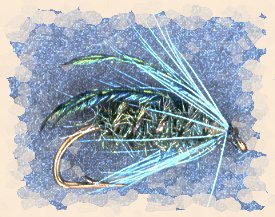Great Canadian Flies
Cedar Borer
By Arthur James Lingren

British Columbia's coastal streams are not prolific bearers
of trout food and that is one of the reasons, wherever possible,
trout migrated and became big in the bountiful sea. However,
there are some rivers such as Haig-Brown's home river, the
Campbell, and the Cowichan where there is a mix of anadromous and
resident trout. Sea-run cutthroat and resident rainbows in the
Campbell and Cowichan are not that particular and will take advantage
of whatever food comes their way, even food of a terrestrial sort.
The coastal forest of British Columbia abound in insect life and every
now and then some accidentally find their way into the water. Haig-Brown
knew this and knew that the large terrestrial beetle was often found in
the stomachs of fish and that fly fishers could profit by an imitation.
About the Cedar Borer, in his The Western Angler
notebook, after listing the fly's ingredients he admitted his fly
"maybe not a good imitation but fish take it well enough." However,
Haig-Brown realized that many flies work some of the time and that
no fly works all the time. Having a broad-based experience fishing
from youth in England, spending some time fishing in Washington
State when he first came to North America, and with close to ten years
fishing in British Columbia, he knew what types of flies catch fish.
In the same notebook, about some of his patterns such as the Brown and
Black caterpillars and the Cedar Borer, he says:
none of these flies are "sure killers" Is there such a thing?
But in the right hands they catch all the fish one needs. Plenty
of others just as good, but I haven't found any much better.
In a note following his listing of the Cedar Borer ingredients in
The Western Angler (1939), Haig-Brown says that
"this is a freak-looking fly" but trout in coastal streams
take this beetle whenever they happen to appear in the water and
that "it is rather comforting to have even the roughest imitation"
(Vol.II, p.175). As a closing note, he says that his "dressing
takes fish well under these conditions."
Details
Hook: Number 6 or 8.
Body: Mixed blue and emerald green seal fur.
Rib: Fine, oval gold tinsel and bronze peacock herl.
Wing: Peacock sword.
Originator: Roderick Haig-Brown.
Intended Use: Wet fly for cutthroat and rainbow trout.
Location: Campbell River, B.C. Canada.
~ Arthur James Lingren
Credits: From Fly Patterns of British Columbia
by Arthur James Lingren. We thank
Frank Amato Publications, Inc. for use permission!
Our Man In Canada Archives
|



